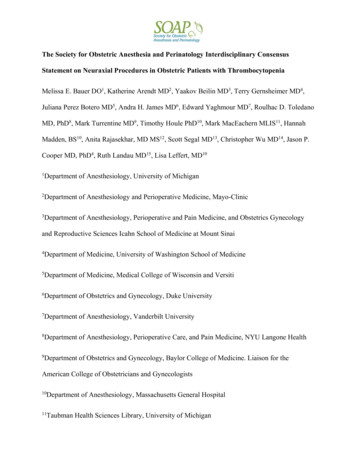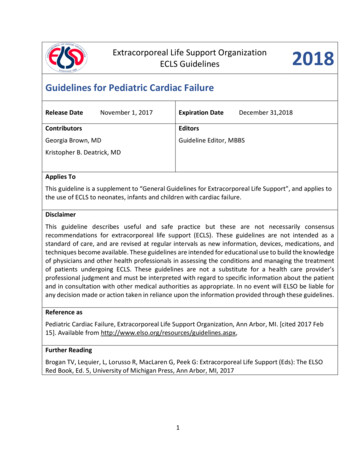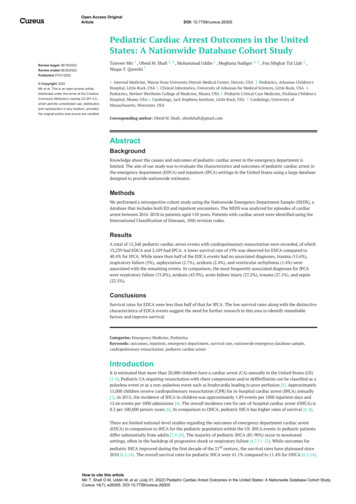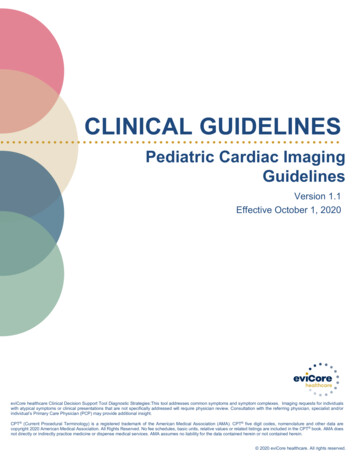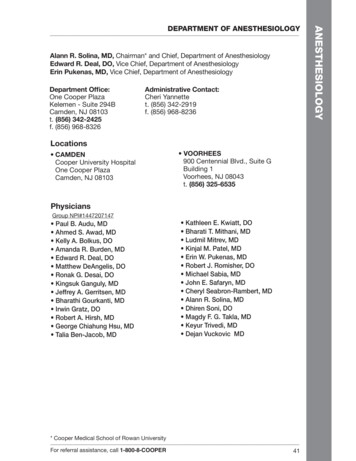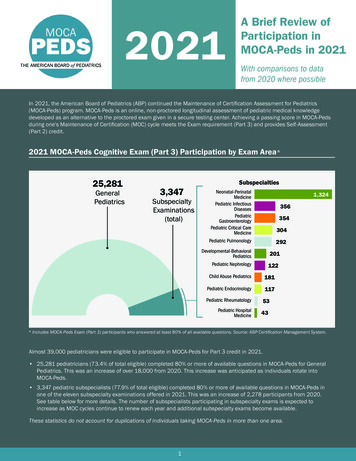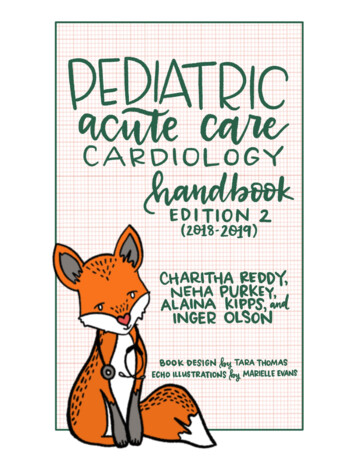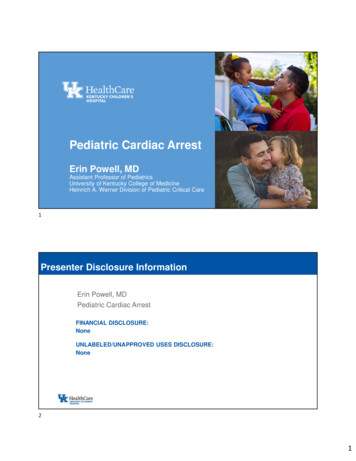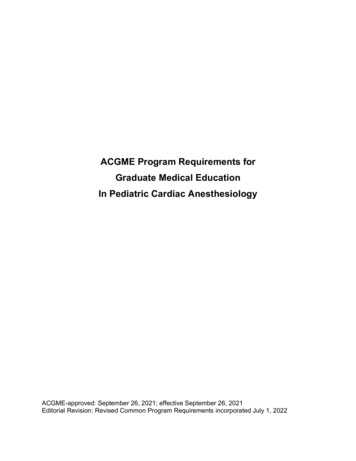
Transcription
ACGME Program Requirements forGraduate Medical EducationIn Pediatric Cardiac AnesthesiologyACGME-approved: September 26, 2021; effective September 26, 2021Editorial Revision: Revised Common Program Requirements incorporated July 1, 2022
ContentsIntroduction . 3Int.A. Preamble . 3Int.B. Definition of Subspecialty . 4Int.C. Length of Educational Program . 4I. Oversight . 4I.A.Sponsoring Institution. 4I.B.Participating Sites . 4I.C.Recruitment. 5I.D.Resources . 6I.E.Other Learners and Other Care Providers . 8II. Personnel. 8II.A. Program Director . 8II.B. Faculty .13II.C. Program Coordinator .16II.D. Other Program Personnel .17III. Fellow Appointments .17III.A. Eligibility Criteria .17III.B. Number of Fellows.19III.C. Fellow Transfers .19IV. Educational Program .19IV.A. Curriculum Components .20IV.B. ACGME Competencies .21IV.C. Curriculum Organization and Fellow Experiences .25IV.D. Scholarship .29V. Evaluation .31V.A. Fellow Evaluation .31V.B. Faculty Evaluation .35V.C. Program Evaluation and Improvement .36VI. The Learning and Working Environment .38VI.A. Patient Safety, Quality Improvement, Supervision, and Accountability .39VI.B. Professionalism .45VI.C. Well-Being .47VI.D. Fatigue Mitigation .50VI.E. Clinical Responsibilities, Teamwork, and Transitions of Care .50VI.F. Clinical Experience and Education.52Pediatric Cardiac Anesthesiology 2022 Accreditation Council for Graduate Medical Education (ACGME)Page 2 of 57
ACGME Program Requirements for Graduate Medical Education inPediatric Cardiac AnesthesiologyCommon Program Requirements (Fellowship) are in BOLDWhere applicable, text in italics describes the underlying philosophy of the requirements in thatsection. These philosophic statements are not program requirements and are therefore notcitable.Background and Intent: These fellowship requirements reflect the fact that theselearners have already completed the first phase of graduate medical education. Thus,is the Common Program Requirements (Fellowship) are intended to explain thedifferences.IntroductionInt.A.Fellowship is advanced graduate medical education beyond a coreresidency program for physicians who desire to enter more specializedpractice. Fellowship-trained physicians serve the public by providingsubspecialty care, which may also include core medical care, acting as acommunity resource for expertise in their field, creating and integratingnew knowledge into practice, and educating future generations ofphysicians. Graduate medical education values the strength that a diversegroup of physicians brings to medical care.Fellows who have completed residency are able to practice independentlyin their core specialty. The prior medical experience and expertise offellows distinguish them from physicians entering into residency training.The fellow’s care of patients within the subspecialty is undertaken withappropriate faculty supervision and conditional independence. Facultymembers serve as role models of excellence, compassion,professionalism, and scholarship. The fellow develops deep medicalknowledge, patient care skills, and expertise applicable to their focusedarea of practice. Fellowship is an intensive program of subspecialty clinicaland didactic education that focuses on the multidisciplinary care ofpatients. Fellowship education is often physically, emotionally, andintellectually demanding, and occurs in a variety of clinical learningenvironments committed to graduate medical education and the well-beingof patients, residents, fellows, faculty members, students, and all membersof the health care team.In addition to clinical education, many fellowship programs advancefellows’ skills as physician-scientists. While the ability to create newknowledge within medicine is not exclusive to fellowship-educatedphysicians, the fellowship experience expands a physician’s abilities topursue hypothesis-driven scientific inquiry that results in contributions tothe medical literature and patient care. Beyond the clinical subspecialtyexpertise achieved, fellows develop mentored relationships built on aninfrastructure that promotes collaborative research.Pediatric Cardiac Anesthesiology 2022 Accreditation Council for Graduate Medical Education (ACGME)Page 3 of 57
Int.B.Definition of SubspecialtyPediatric cardiac anesthesiology is devoted to the peri-operative care of patientswith congenital heart disease undergoing congenital cardiac surgery and relatedinvasive and diagnostic procedures.The clinical education includes experience providing anesthesia for cardiacpatients in peri-operative and peri-procedural areas.Int.C.Length of Educational ProgramThe educational program in pediatric cardiac anesthesiology must be 12 monthsin length. (Core)*I.OversightI.A.Sponsoring InstitutionThe Sponsoring Institution is the organization or entity that assumes theultimate financial and academic responsibility for a program of graduatemedical education consistent with the ACGME Institutional Requirements.When the Sponsoring Institution is not a rotation site for the program, themost commonly utilized site of clinical activity for the program is theprimary clinical site.Background and Intent: Participating sites will reflect the health care needs of thecommunity and the educational needs of the fellows. A wide variety of organizationsmay provide a robust educational experience and, thus, Sponsoring Institutions andparticipating sites may encompass inpatient and outpatient settings including, but notlimited to a university, a medical school, a teaching hospital, a nursing home, aschool of public health, a health department, a public health agency, an organizedhealth care delivery system, a medical examiner’s office, an educational consortium, ateaching health center, a physician group practice, federally qualified health center, oran educational foundation.I.A.1.I.B.The program must be sponsored by one ACGME-accreditedSponsoring Institution. (Core)*Participating SitesA participating site is an organization providing educational experiences oreducational assignments/rotations for fellows.I.B.1.The program, with approval of its Sponsoring Institution, mustdesignate a primary clinical site. (Core)I.B.1.a)The Sponsoring Institution must sponsor an ACGME-accreditedprogram in pediatric anesthesiology. (Core)I.B.1.b)There must be only one pediatric cardiac anesthesiology programPediatric Cardiac Anesthesiology 2022 Accreditation Council for Graduate Medical Education (ACGME)Page 4 of 57
associated with a single anesthesiology program. (Core)I.B.2.I.B.2.a)There must be a program letter of agreement (PLA) between theprogram and each participating site that governs the relationshipbetween the program and the participating site providing a requiredassignment. (Core)The PLA must:I.B.2.a).(1)be renewed at least every 10 years; and, (Core)I.B.2.a).(2)be approved by the designated institutional official(DIO). (Core)I.B.3.I.B.3.a)The program must monitor the clinical learning and workingenvironment at all participating sites. (Core)At each participating site there must be one faculty member,designated by the program director, who is accountable forfellow education for that site, in collaboration with theprogram director. (Core)Background and Intent: While all fellowship programs must be sponsored by a singleACGME-accredited Sponsoring Institution, many programs will utilize other clinicalsettings to provide required or elective training experiences. At times it is appropriateto utilize community sites that are not owned by or affiliated with the SponsoringInstitution. Some of these sites may be remote for geographic, transportation, orcommunication issues. When utilizing such sites, the program must designate afaculty member responsible for ensuring the quality of the educational experience. Insome circumstances, the person charged with this responsibility may not be physicallypresent at the site, but remains responsible for fellow education occurring at the site.The requirements under I.B.3. are intended to ensure that this will be the case.Suggested elements to be considered in PLAs will be found in the ACGME ProgramDirector’s Guide to the Common Program Requirements. These include: Identifying the faculty members who will assume educational and supervisoryresponsibility for fellows Specifying the responsibilities for teaching, supervision, and formal evaluationof fellows Specifying the duration and content of the educational experience Stating the policies and procedures that will govern fellow education during theassignmentI.B.4.I.C.The program director must submit any additions or deletions ofparticipating sites routinely providing an educational experience,required for all fellows, of one month full time equivalent (FTE) ormore through the ACGME’s Accreditation Data System (ADS). (Core)The program, in partnership with its Sponsoring Institution, must engage inpractices that focus on mission-driven, ongoing, systematic recruitmentPediatric Cardiac Anesthesiology 2022 Accreditation Council for Graduate Medical Education (ACGME)Page 5 of 57
and retention of a diverse and inclusive workforce of residents (if present),fellows, faculty members, senior administrative staff members, and otherrelevant members of its academic community. (Core)Background and Intent: It is expected that the Sponsoring Institution has, and programsimplement, policies and procedures related to recruitment and retention of minoritiesunderrepresented in medicine and medical leadership in accordance with theSponsoring Institution’s mission and aims. The program’s annual evaluation mustinclude an assessment of the program’s efforts to recruit and retain a diverse workforce,as noted in V.C.1.c).(5).(c).I.D.I.D.1.ResourcesThe program, in partnership with its Sponsoring Institution, mustensure the availability of adequate resources for fellow education.(Core)I.D.1.a)The program must have access to the following resources:I.D.1.a).(1)an emergency department in which pediatric cardiacpatients are managed 24 hours a day; (Core)I.D.1.a).(2)a post-anesthesia care area equipped for the managementof pediatric cardiac patients and located near the operatingroom suite; (Core)I.D.1.a).(3)facilities and equipment for research in cardiacanesthesiology; (Core)I.D.1.a).(4)facilities, available at all times, to provide prompt, noninvasive and invasive diagnostic and therapeuticcongenital cardiac procedures, includingechocardiography, cardiac stress testing, cardiaccatheterization, electrophysiological testing andtherapeutic intervention, cardiopulmonary scanningprocedures, and pulmonary function testing; (Core)I.D.1.a).(5)laboratories, available at all times, that provide promptresults, including blood chemistries, blood gas and acidbase analysis oxygen saturation, hematocrit/hemoglobin,and coagulation function; (Core)I.D.1.a).(6)monitoring and advanced life and circulatory supportequipment representative of current levels of technology;(Core)I.D.1.a).(7)neonatal and pediatric intensive care units (ICUs) for bothsurgical and non-surgical cardiac patients; (Core)I.D.1.a).(8)operating rooms equipped for the management of pediatriccardiac patients; and, (Core)Pediatric Cardiac Anesthesiology 2022 Accreditation Council for Graduate Medical Education (ACGME)Page 6 of 57
I.D.1.a).(9)I.D.2.prompt, reliable systems for communication and interactionwith supervisory physicians. (Core)The program, in partnership with its Sponsoring Institution, mustensure healthy and safe learning and working environments thatpromote fellow well-being and provide for: (Core)I.D.2.a)access to food while on duty; (Core)I.D.2.b)safe, quiet, clean, and private sleep/rest facilities availableand accessible for fellows with proximity appropriate for safepatient care; (Core)Background and Intent: Care of patients within a hospital or health system occurscontinually through the day and night. Such care requires that fellows function attheir peak abilities, which requires the work environment to provide them with theability to meet their basic needs within proximity of their clinical responsibilities.Access to food and rest are examples of these basic needs, which must be met whilefellows are working. Fellows should have access to refrigeration where food may bestored. Food should be available when fellows are required to be in the hospitalovernight. Rest facilities are necessary, even when overnight call is not required, toaccommodate the fatigued fellow.I.D.2.c)clean and private facilities for lactation that have refrigerationcapabilities, with proximity appropriate for safe patient care;(Core)Background and Intent: Sites must provide private and clean locations where fellowsmay lactate and store the milk within a refrigerator. These locations should be in closeproximity to clinical responsibilities. It would be helpful to have additional supportwithin these locations that may assist the fellow with the continued care of patients,such as a computer and a phone. While space is important, the time required forlactation is also critical for the well-being of the fellow and the fellow's family, asoutlined in VI.C.1.d).(1).I.D.2.d)security and safety measures appropriate to the participatingsite; and, (Core)I.D.2.e)accommodations for fellows with disabilities consistent withthe Sponsoring Institution’s policy. (Core)I.D.3.Fellows must have ready access to subspecialty-specific and otherappropriate reference material in print or electronic format. Thismust include access to electronic medical literature databases withfull text capabilities. (Core)I.D.4.The program’s educational and clinical resources must be adequateto support the number of fellows appointed to the program. (Core)I.D.4.a)The number and diversity of patients available to the programPediatric Cardiac Anesthesiology 2022 Accreditation Council for Graduate Medical Education (ACGME)Page 7 of 57
must support the required inpatient and outpatient experience foreach fellow. (Core)I.E.A fellowship program usually occurs in the context of many learners andother care providers and limited clinical resources. It should be structuredto optimize education for all learners present.I.E.1.Fellows should contribute to the education of residents in coreprograms, if present. (Core)I.E.2.The presence of other learners or staff members in the program must notinterfere with the appointed fellows’ education. (Core)Background and Intent: The clinical learning environment has become increasinglycomplex and often includes care providers, students, and post-graduate residents andfellows from multiple disciplines. The presence of these practitioners and their learnersenriches the learning environment. Programs have a responsibility to monitor the learningenvironment to ensure that fellows’ education is not compromised by the presence ofother providers and learners, and that fellows’ education does not compromise coreresidents’ education.II.PersonnelII.A.II.A.1.Program DirectorThere must be one faculty member appointed as program directorwith authority and accountability for the overall program, includingcompliance with all applicable program requirements. (Core)II.A.1.a)The Sponsoring Institution’s Graduate Medical EducationCommittee (GMEC) must approve a change in programdirector. (Core)II.A.1.b)Final approval of the program director resides with theReview Committee. (Core)Background and Intent: While the ACGME recognizes the value of input from numerousindividuals in the management of a fellowship, a single individual must be designated asprogram director and have overall responsibility for the program. The program director’snomination is reviewed and approved by the GMEC. Final approval of the programdirector resides with the applicable ACGME Review Committee.II.A.2.II.A.2.a)The program director and, as applicable, the program’s leadershipteam, must be provided with support adequate for administration ofthe program based upon its size and configuration. (Core)At a minimum, the program director must be provided with thededicated time and support specified below for administration ofthe program: (Core)Pediatric Cardiac Anesthesiology 2022 Accreditation Council for Graduate Medical Education (ACGME)Page 8 of 57
Number of ApprovedFellow Positions1-2345 5Minimum FTE0.10.1250.150.1750.2Background and Intent: To achieve successful graduate medical education, individualsserving as education and administrative leaders of fellowship programs, as well as thosesignificantly engaged in the education, supervision, evaluation, and mentoring of fellows,must have sufficient dedicated professional time to perform the vital activities required tosustain an accredited program.The ultimate outcome of graduate medical education is excellence in fellow educationand patient care.The program director and, as applicable, the program leadership team, devote a portionof their professional effort to the oversight and management of the fellowship program,as defined in II.A.4.-II.A.4.a).(16). Both provision of support for the time required for theleadership effort and flexibility regarding how this support is provided are important.Programs, in partnership with their Sponsoring Institutions, may provide support for thistime in a variety of ways. Examples of support may include, but are not limited to, salarysupport, supplemental compensation, educational value units, or relief of time from otherprofessional duties.Program directors and, as applicable, members of the program leadership team, who arenew to the role may need to devote additional time to program oversight andmanagement initially as they learn and become proficient in administering the program. Itis suggested that during this initial period the support described above be increased asneeded.In addition, it is important to remember that the dedicated time and support requirementfor ACGME activities is a minimum, recognizing that, depending on the unique needs ofthe program, additional support may be warranted.II.A.3.Qualifications of the program director:II.A.3.a)must include subspecialty expertise and qualificationsacceptable to the Review Committee; (Core)II.A.3.b)must include current certification in the subspecialty ofpediatric anesthesiology or adult cardiothoracic anesthesiology bythe American Board of Anesthesiology or by the AmericanOsteopathic Board of Anesthesiology, or subspecialtyqualifications that are acceptable to the Review Committee;(Core)[Note that while the Common Program Requirements deemcertification by a member board of the American Board of MedicalPediatric Cardiac Anesthesiology 2022 Accreditation Council for Graduate Medical Education (ACGME)Page 9 of 57
Specialties (ABMS) or a certifying board of the AmericanOsteopathic Association (AOA) acceptable, there is no ABMS orAOA board that offers certification in this subspecialty.]II.A.3.b).(1)If certified in adult cardiothoracic anesthesiology, theprogram director must demonstrate experience, expertise,and scholarship in pediatric cardiac anesthesiology. (Core)II.A.3.c)must include current appointment as a member of the pediatricanesthesiology faculty at the primary clinical site; (Core)II.A.3.d)must include demonstration of completion of a pediatric cardiacanesthesiology fellowship, and/or at least three years ofparticipation in a clinical pediatric cardiac anesthesiologyfellowship as a faculty member; (Core)II.A.3.e)must include at least three years of post-fellowship experience inclinical pediatric cardiac anesthesiology; (Core)II.A.3.f)must include demonstration of ongoing academic achievementsappropriate to the subspecialty, including publications, thedevelopment of educational programs, or the conduct of research;and, (Core)II.A.3.g)must include devotion of at least 50 percent of the programdirector’s clinical, educational, administrative, and academic timeto pediatric cardiac anesthesiology. (Core)II.A.4.Program Director ResponsibilitiesThe program director must have responsibility, authority, andaccountability for: administration and operations; teaching andscholarly activity; fellow recruitment and selection, evaluation, andpromotion of fellows, and disciplinary action; supervision of fellows;and fellow education in the context of patient care. (Core)II.A.4.a)II.A.4.a).(1)The program director must:be a role model of professionalism; (Core)Background and Intent: The program director, as the leader of the program, must serveas a role model to fellows in addition to fulfilling the technical aspects of the role. Asfellows are expected to demonstrate compassion, integrity, and respect for others, theymust be able to look to the program director as an exemplar. It is of utmost importance,therefore, that the program director model outstanding professionalism, high qualitypatient care, educational excellence, and a scholarly approach to work. The programdirector creates an environment where respectful discussion is welcome, with the goalof continued improvement of the educational experience.II.A.4.a).(2)design and conduct the program in a fashionconsistent with the needs of the community, thePediatric Cardiac Anesthesiology 2022 Accreditation Council for Graduate Medical Education (ACGME)Page 10 of 57
mission(s) of the Sponsoring Institution, and themission(s) of the program; (Core)Background and Intent: The mission of institutions participating in graduate medicaleducation is to improve the health of the public. Each community has health needs thatvary based upon location and demographics. Programs must understand the socialdeterminants of health of the populations they serve and incorporate them in the designand implementation of the program curriculum, with the ultimate goal of addressingthese needs and health disparities.II.A.4.a).(3)administer and maintain a learning environmentconducive to educating the fellows in each of theACGME Competency domains; (Core)Background and Intent: The program director may establish a leadership team to assistin the accomplishment of program goals. Fellowship programs can be highly complex.In a complex organization the leader typically has the ability to delegate authority toothers, yet remains accountable. The leadership team may include physician and nonphysician personnel with varying levels of education, training, and experience.II.A.4.a).(4)develop and oversee a process to evaluate candidatesprior to approval as program faculty members forparticipation in the fellowship program education andat least annually thereafter, as outlined in V.B.; (Core)II.A.4.a).(5)have the authority to approve program facultymembers for participation in the fellowship programeducation at all sites; (Core)II.A.4.a).(6)have the authority to remove program facultymembers from participation in the fellowship programeducation at all sites; (Core)II.A.4.a).(7)have the authority to remove fellows from supervisinginteractions and/or learning environments that do notmeet the standards of the program; (Core)Background and Intent: The program director has the responsibility to ensure that allwho educate fellows effectively role model the Core Competencies. Working with afellow is a privilege that is earned through effective teaching and professional rolemodeling. This privilege may be removed by the program director when the standardsof the clinical learning environment are not met.There may be faculty in a department who are not part of the educational program, andthe program director controls who is teaching the residents.II.A.4.a).(8)submit accurate and complete information requiredand requested by the DIO, GMEC, and ACGME; (Core)Pediatric Cardiac Anesthesiology 2022 Accreditation Council for Graduate Medical Education (ACGME)Page 11 of 57
II.A.4.a).(9)provide applicants who are offered an interview withinformation related to the applicant’s eligibility for therelevant subspecialty board examination(s); (Core)II.A.4.a).(10)provide a learning and working environment in whichfellows have the opportunity to raise concerns andprovide feedback in a confidential manner asappropriate, without fear of intimidation or retaliation;(Core)II.A.4.a).(11)ensure the program’s compliance with the SponsoringInstitution’s policies and procedures related togrievances and due process; (Core)II.A.4.a).(12)ensure the program’s compliance with the SponsoringInstitution’s policies and procedures for due processwhen action is taken to suspend or dismiss, not topromote, or not to renew the appointment of a fellow;(Core)Background and Intent: A program does not operate independently of its SponsoringInstitution. It is expected that the program director will be aware of the SponsoringInstitution’s policies and procedures, and will ensure they are followed by theprogram’s leadership, faculty members, support personnel, and fellows.II.A.4.a).(13)II.A.4.a).(13).(a)ensure the program’s compliance with the SponsoringInstitution’s policies and procedures on employmentand non-discrimination; (Core)Fellows must not be required to sign a noncompetition guarantee or restrictive covenant.(Core)II.A.4.a).(14)document verification of program completion for allgraduating fellows within 30 days; (Core)II.A.4.a).(15)provide verification of an individual fellow’scompletion upon the fellow’s request, within 30 days;and, (Core)Background and Intent: Primary verification of graduate medical education isimportant to credentialing of physicians for further training and practice. Suchverification must be accurate and timely. Sponsoring Institution and program policiesfor record retention are important to facilitate timely documentation of fellows whohave previously completed the program. Fellows who leave the program prior tocompletion also require timely documentation of their summative evaluation.II.A.4.a).(16)obtain review and approval of the SponsoringInstitution’s DIO before submitting information orrequests to the ACGME, as required in the InstitutionalRequirements and outlined in the ACGME ProgramPediatric Cardiac Anesthesiology 2022 Accreditation Council for Graduate Medical Education (ACGME)Page 12 of 57
Director’s Guide to the Common ProgramRequirements. (Core)II.B.FacultyFaculty members are a foundational element of graduate medical education– faculty members teach fellows how to care for patients. Faculty membersprovide an important bridge allowing fellows to grow and become practiceready, ensuring that patients receive the highest quality of care. They arerole models for future generations of physicians by demonstratingcompassion, commitment to excellence in teaching and patient care,professionalism, and a dedication to lifelong learning. Faculty membersexperience the pride and joy of fostering the growth and development offuture colleagues. The c
In Pediatric Cardiac Anesthesiology . ACGME-approved: September 26, 2021; effective September 26, 2021 . Editorial Revision: Revised Common Program Requirements incorporated July 1, 2022 . Pediatric Cardiac Anesthesiology 2022 Accreditation Council for Graduate Medical Education (ACGME) Page 2 of 57.


